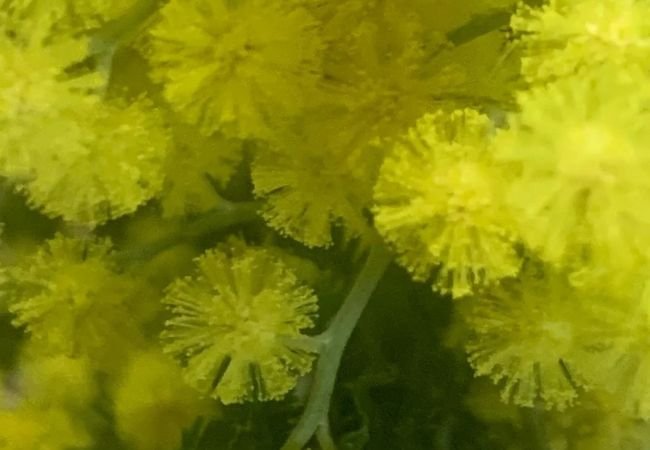Discover the fascinating Mimosa Flower – learn about its unique features, how to grow it and why it’s called the “sensitive plant.” A guide for curious gardeners and nature lovers alike.
Have you ever seen a plant that moves when you touch it? That’s the Mimosa! Also known as the “sensitive plant” or “touch-me-not,” Mimosa is a unique and interesting plant that can add fun to any garden. Let’s explore this special plant and learn how to grow it.
Here’s a detailed chart for Mimosa flowers:
| Category | Information |
|---|---|
| Botanical name | Albizia julibrissin |
| Common name | Mimosa, Silk Tree |
| Plant type | Deciduous tree |
| Hardiness zone | Zones 6-9 |
| Sun exposure | Full sun to part shade |
| Soil type | Well-drained soil, tolerates poor soils |
| Watering | Moderate watering, drought tolerant |
| Growth habit | Spreading, umbrella-shaped canopy |
| Height/Spread | 20-40 feet tall, 20-50 feet wide |
| Special features | Fragrant, pink pom-pom-like flowers, attracts pollinators, fast-growing |
What is Mimosa?

Mimosa, scientifically called Mimosa pudica, is a flowering plant that’s famous for its leaves that close when touched. It’s originally from South America but now grows in many warm parts of the world.
What Does Mimosa Look Like?
- Leaves: Feathery and green, they fold up when touched
- Flowers: Small, round and pinkish-purple
- Stems: Can be a bit prickly
- Size: Usually grows 1-2 feet tall
To learn more about unique plants, visit the USDA Plants Database.
Why Does Mimosa Move?
Mimosa leaves close when touched as a defense against animals that might eat them. This movement is called thigmonasty. Scientists are still studying how exactly the plant does this.
For more on plant movement, check out the National Science Foundation’s plant science page.
Growing Mimosa at Home
Want to grow your own Mimosa? Here’s what you need:
- Light: Mimosa likes full sun or partial shade
- Soil: Well-draining soil is best
- Water: Keep the soil moist but not soggy
- Temperature: Warm temperatures above 60°F (15°C)
For general gardening tips, visit the National Gardening Association.
Planting Mimosa
You can grow Mimosa from seeds:
- Soak the seeds in warm water for a day before planting
- Plant seeds in small pots with potting soil
- Keep the soil warm and moist
- Seeds should sprout in 1-2 weeks
Caring for Mimosa
Mimosa is pretty easy to care for:
- Water regularly, but don’t let the soil get too wet
- Fertilize once a month during growing season
- Prune if the plant gets too big
- Bring indoor plants outside sometimes for fresh air and sunlight
Mimosa as a Houseplant
Mimosa can grow well indoors:
- Place near a sunny window
- Use a pot with drainage holes
- Keep away from cold drafts
- Mist the leaves to increase humidity
For tips on indoor plant care, check out the USDA’s Indoor Plant Care page.
Uses of Mimosa
While Mimosa is mostly grown for fun, it has other uses too:
- Education: Great for teaching kids about plants
- Traditional medicine: Used in some cultures, but always check with a doctor first
- Gardening: Can be a unique addition to gardens
To learn about using plants safely, visit the FDA’s page on botanical products.
Mimosa and Wildlife
Mimosa flowers can attract pollinators like bees and butterflies to your garden. However, in some areas, Mimosa can spread quickly and become invasive.
Potential Problems
Watch out for these issues:
- Overwatering: Can cause root rot
- Cold temperatures: Mimosa doesn’t like the cold
- Pests: Look out for spider mites and whiteflies
If you have plant problems, you can ask for help at your local garden center or contact your state’s Cooperative Extension office.
Mimosa in Science
Scientists study Mimosa to learn about plant movement and sensitivity. This research might help us understand plants better and even create new technologies.
For more on plant science, visit the Botanical Society of America.
Mimosa is a fascinating plant that can bring joy and wonder to your garden or home. Its moving leaves make it a great conversation starter and a fun way to get kids interested in plants. While it needs some specific care, growing Mimosa can be a rewarding experience for any plant lover.
Remember, every plant is unique and might need slightly different care. Don’t be afraid to experiment and find what works best for your Mimosa. Happy growing!
For more gardening tips and plant care guides, visit usagardenhub.com.

